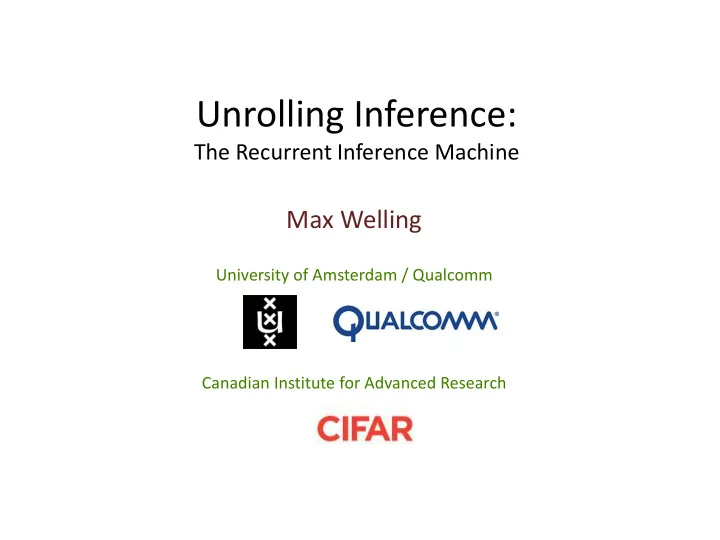

Unrolling Inference: The Recurrent Inference Machine Max Welling University of Amsterdam / Qualcomm Canadian Institute for Advanced Research
ML @ UvA (2 fte) (12fte) Machine Learning in Amsterdam (12fte) (3fte) (10fte) (4fte)
Overview • Meta learning • Recurrent Inference Machine • Application to MRI • Application radio astronomy • Conclusions
2016 • Train an optimizer to choose the best parameter updates by solving many optimization problems and learn the patterns. • Unroll gradient optimizer, then abstract into a parameterized computation graph, e.g. RNN
2017 • Learning a planning algorithm to execute the best actions by solve many different RL.
2017 • One shot learning: meta-learn a learning algorithm to classify from very few examples
2017 • Learning a NN architecture using active learning / reinforcement learning Bayesian optimization
The Recipe • Study the classical iterative optimization algorithm • Unroll the computation tree and cut it off at T steps (layers) • Generalize / parameterize the individual steps • Create targets at the last layer • Backpropagate through the ”deep network” to fit the parameters • Execute the network to make predictions
Learning to Infer • Unroll a known iterative inference scheme (e.g. mean field, belief propagation) • Abstract into parameterized computation graph for fixed nr. iterations, e.g. RNN • Learn parameters of RNN using meta-learning (e.g. solving many inference problems)
Graph Convolutions Thomas Kipf
Convolutions vs Graph Convolutions vs.
Convolutions vs Graph Convolutions vs.
Graph Convolutions
Graph Convolutional Networks Kipf & Welling ICLR (2017)
Application to Airway Segmentation (work in progress, with Rajhav Selvan & Thomas Kipf)
Inverse Problems w/ Patrick Putzky Quantity of interest Measurement Forward Model Inverse Model Forward Model Inverse Model
The Usual Approach prior (learn) observations generative model (known) advantage: model P(X) and optimization are separated. disadvantage: accuracy suffers because model and optimization interact …
Learning Inference: Recurrent Inference Machine • Abstract and parameterize computation graph into RNN • Integrate prior P(X) in RNN • Add memory state s • Meta learn the parameters of the RNN
Recurrent Inference Machine (RIM) Learn to optimize using a RNN. CNN/RNN memory state external information
Recurrent Inference Machine + 3x3 conv GRU 3x3, 64, atrous 2 Embedding 5x5, 64 Time
Recurrent Inference Machines in Time Objective
Simple Super-Resolution Time
Reconstruction from Random Projections 32 x 32 pixel image patches Fast Convergence on all tasks
Image Denoising Denoising trained on small image patches, generalises to full-sized images
Super-resolution LR HR Bicubic Interpolation RIM
Super-resolution
Square Kilometer Array Jorn Peters Up to 14.4 Gigapixels With thousands of Channels
Deep Learning for Inverse Problems w/ Kai Lonning & Matthan Caan E.g. MRI Image Reconstruction
http://sbt.science.uva.nl/mri/about/ (Slides and website made by Kai Lonning) Example of training data point, 30x30 image patch Testing done on full images, sub- sampling masks shown for 6x, 4x and 2x acceleration
A full brain RIM reconstruction, starting from the 4 times sub-sampled corruption on the left, attempting to recover the target on the right.
Each time-step in the Recurrent Inference Machine produces a new estimate, here shown to the left, from the 3x accelerated corruption until the 10th and final reconstruction. Target is in the middle, while the error (not to scale) is shown to the right.
Conclusions • Meta learning is interesting new paradigm that can improve classical optimization and inference algorithms by exploiting patterns in classes of problems. • RIM is a method that unrolls inference and learns to solve inverse problems. • Great potential to improve & speed up radio-astronomy and MRI image reconstruction. • Application to MRI-linac?
Recommend
More recommend